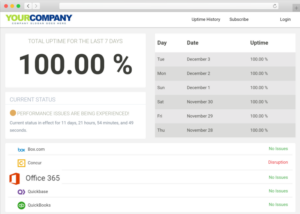Background
If you’re an Office 365 administrator, you know that accessing the Office 365 Service Status page can be somewhat time consuming and complicated. It’s no surprise that when there’s an O365 outage, your employees come running to you instead of looking up the problem on their own. This can be a huge drain on IT help desk resources.
Unlike most SaaS public pages, the Office365 status page is a private status page. The O365 architecture is not a purely multi-tenant service. This means that Microsoft can’t provide a single status page for all of their customers. Your version of O365 is provisioned differently than everyone else, therefore Microsoft has chosen to provide a unique status page experience to every customer. The O365 status page is only accessible behind your authenticated O365 user account.
With the integration of O365 on to your corporate StatusCast status page, Office 365 incidents now flow seamlessly from your private O365 account in to your status page and incident management solution. From within StatusCast’s administration, you have full control as to how this information is propagated to your employees:
- Decide specifically which users have access to which O365 services.
- Show only the most relevant services on your status page (not using Yammer? then just hide it).
- Allow end users to subscribe to O365 incidents directly from your status page. This acts the same way they would subscribe to any other internal or external service that you have made available.
- Control the publication of new O365 incidents with advanced administration. Allow your IT team to intercept the message before its get broadcast via e-mail, text, SMS, etc.
A Unified View for Incident Notifications
We all know that getting relevant information to employees about ongoing IT incidents is critical. By ensuring the company knows what’s going on within your business IT infrastructure, employees maintain optimum productivity. More importantly, your IT help desk is saved from the flood of inbound tickets that typically arise during an outage. If you don’t already have a private, employee facing status page to help manage this process, now is the time to consider getting one.
The easiest way to get a status page up and running for you employees is to include all of their favorite existing SaaS products. Most SaaS companies have their own status page, however, ensuring all your employees know about them and are using them properly can be painful. When your employees are directly responsible for watching SaaS outages, you lose the ability to ensure they are watching, or to track and control the message they are delivered.
A status page service like StatusCast lets you consolidate the status of all your SaaS providers onto your internal page, and thereby control the workflow, notification process, and messaging.
According to the article 2018’s Top Business Apps in Inc. Magazine Office 365 is the most popular SaaS business application on the market today. Followed by Salesforce, Amazon Web Services, Google GSuite, Box, Slack, SAP Concur, Jira, Zoom, and Cisco Meraki. With this integration, StatusCast now officially integrates with 9 of them.







